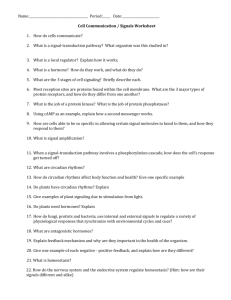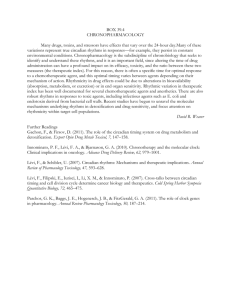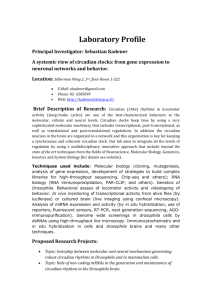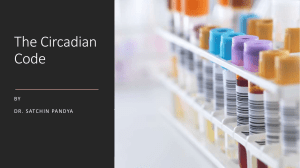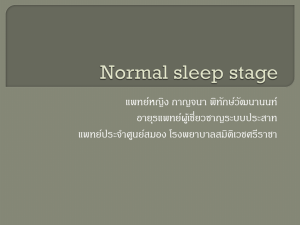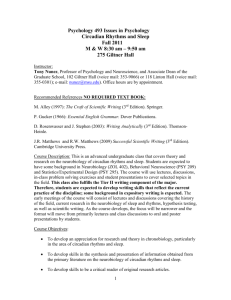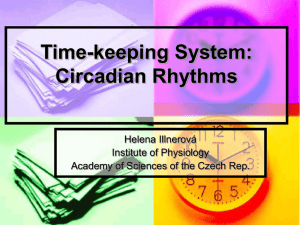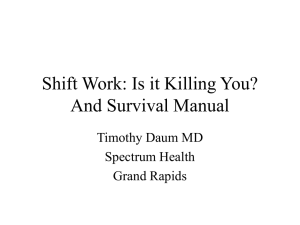Dr. Nate Kingsbury`s presentation on modeling circadian rhythms
advertisement
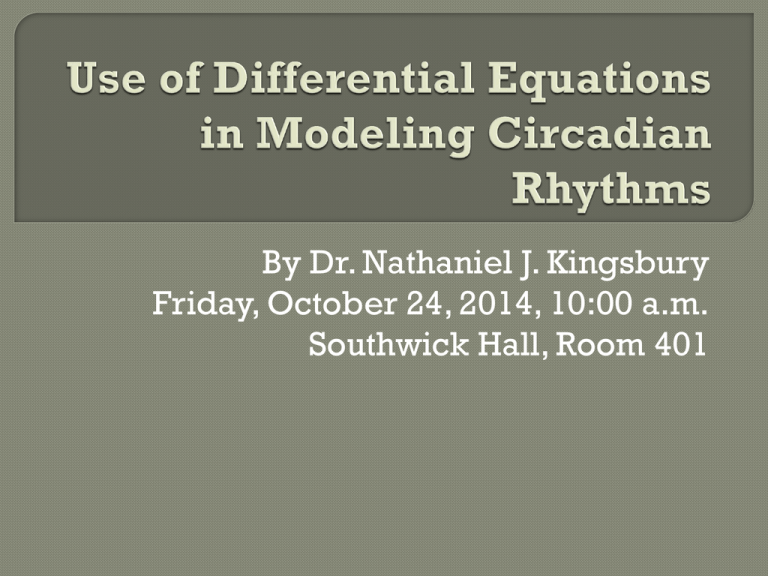
By Dr. Nathaniel J. Kingsbury Friday, October 24, 2014, 10:00 a.m. Southwick Hall, Room 401 In this seminar, I will… Explore the biology of circadian rhythms and provide motivation for modeling them Show the importance of differential equations in modeling circadian rhythms Present results and conclusions from active research Circadian Rhythms: It’s Night and Day Circadian=24-hour cycle; Your biological clock Controls your sleep and other patterns Found in most life forms Is genetic Must be flexible Systems biologists can describe them using differential equations Maladies of Poor Circadian Rhythms 4 Elderly suffer in particular: Sleep loss and early wake times1 Poor mood, poor memory, cognitive decline2 Linked to accidents, other health problems, and mortality3 1Buysse D. et. al. (2005) Circadian patterns of sleep, sleepiness, and performance in older and younger adults. Sleep 28:1365–1376 2 Grandner, M. et. al. (2012) Age and sleep disturbances among American men and women: data from the US Behavioral Risk Factor Surveillance System. Sleep 35:395–406 3 Ancoli-Israel S, Alessi C (2005) Sleep and aging. Am J Geriatr Psychiatr 13:341–343 4http://over40fitnessguide.com/wp-images/tired-elderly.jpg, Accessed April 23, 2014 The Suprachiasmatic Nucleus (SCN) The brain can be divided by region, and each region has a distinct function The SCN is one of the best examples of this SCN https://angelosscienceportfolio.files.wordpress.com/2013/04/regions_of_the_brain_and_their_functions.jpg, Accessed April 23, 2014 https://a248.e.akamai.net/media.pinterest.com.s3.amazonaws.com/736x/e5/59/1a/e5591a7d78e177db8d6a80d5168123cb.jpg, Accessed April 23, 2014 The Suprachiasmatic Nucleus (SCN): An experiment Mice Population 1 Mice Population 2 Lights were on from 5am-5pm Lights were on from 5pm-5am Exercised at 5pm Exercised at 5am Lights were off for 24h; rhythm is preserved Lights were off for 24h; rhythm preserved SCN was surgically removed; rhythm is lost SCN was surgically removed, rhythm is lost SCN from Population 1 was transplanted into Population 2 Continued to exercise at random times Got rhythm from Pop 1, exercised at 5pm Adapted from: Sujino, M. et al. (2003) Suprachiasmatic nucleus grafts restore circadian behavioral rhythms of genetically arrhythmic mice. Curr. Biol. 13, 664–668 More Experimental Techniques: Bioluminescence Freeman, et. al. “GABA Networks Destabilize Genetic Oscillations in the Circadian Pacemaker.” Neuron 78, 799–806, 2013. More experimental techniques: Microelectrode arrays 200µm Freeman, et. al. “GABA Networks Destabilize Genetic Oscillations in the Circadian Pacemaker.” Neuron 78, 799–806, 2013. Why Model Systems biologists can use models to describe an entire complex network in entirety Experiments are time and energy intensive Models can be used to validate phenomena found during experiment Models can develop hypotheses testable in a lab Limit Cycle Oscillators Strogatz, Steven H. "Exploring complex networks." Nature 410.6825 (2001): 268-276. Types of Networks Strogatz, Steven H. "Exploring complex networks." Nature 410.6825 (2001): 268-276. Model Network vs. Experimental Network Making the Network Network (Graph) Adjacency matrix Circadian Rhythm Model 21 components, 21 ODEs Modeled for each cell within the network Represent the core molecular clock DNA mRNA Protein + - Hexokinase https://en.wikipedia.org/wiki/File:Hexokinase_ball_and_stick_model,_with _substrates_to_scale_copy.png, Accessed May 1, 2014 Biological Oscillations If A B; positive feedback; A B If A B; negative feedback; A B Repressilator example: A,B, and C are all molecules present inside a bacterial cell A B, B C, C A Proteins per cell A— B— C— time (minutes) Neurotransmitters connect the network VIP (vasoactive intestinal peptide): excitatory; stimulates transcription of Period gene GABA (γ-aminobutyric acid): inhibitory; reduces firing rate Types of model manipulation: light entrainment Entrainment of the network to lightdark cycles. Phase shifts (simulates jet lag) Length of daylight period Days We are very interested in learning what is important for resynchronization to this kind of phase shift 0 12 24 time of day (h) Basic Output Example To speed up or slow down? Advancers Switchers (w/GABA) Delayers 12:00 am 9:00am Conclusions Systems biology: modeling complex biological systems Models of circadian rhythms all employ ODEs My model closely simulates tissue topology, cell machinery, and signaling Goal of my research is to find and communicate hypotheses that may be tested experimentally My model helps describe how the brain works!
